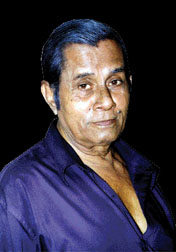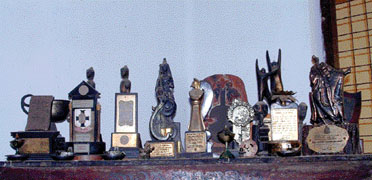A veteran artiste still at work
Tissa Gunewardene
 Officially, he is a retired teacher, yet he continues with his work
regardless of his age. Every morning he could be seen in his usual calm
environment, going about his daily rituals just like in his heyday. The
pen, ruler, the level, the trowel, the paint brush and all the other
equipment work under his order, even though his left arm is paralysed.
The master craftsman, the artist, the sculptor, the dramatist and script
writer, Tissa Gunewardene is a versatile personality who cannot be kept
down by age or illness. Officially, he is a retired teacher, yet he continues with his work
regardless of his age. Every morning he could be seen in his usual calm
environment, going about his daily rituals just like in his heyday. The
pen, ruler, the level, the trowel, the paint brush and all the other
equipment work under his order, even though his left arm is paralysed.
The master craftsman, the artist, the sculptor, the dramatist and script
writer, Tissa Gunewardene is a versatile personality who cannot be kept
down by age or illness.
Even though he descends from Baddegama, he resided at Kalutara and
attended Kalutara Vidyalaya, which was a very famous school for artists
then. Veterans like Amaradeva, Chithrasena, Vajira and Narada
Dissasekara have studied performing arts at this school.
According to Tissa Gunewardene, he had a strong inclination to draw,
act and sculpt as a youngster. “I always drew pictures and engaged in
sculpting. I had a strong desire to do something great someday, like
make the world’s largest statue”, he explained with a smile.
“So, wherever I went, I had this habit of bringing back some clay
from that area to do sculptures. Most of the time I went towards Horana
to get clay. I used to store it in the garage,” he added recalling his
early days.
Sometimes, he had been very much disturbed to see some of the items
he had painstakingly turned out the previous evening, lying all cracked
up the next morning. But he hadn’t given up on his work. His siblings
had also helped him in his endeavours and given him all the freedom to
work undisturbed.
 |
|
Some of the
awards Gunewardene has won |
“The principal of my school helped me a great deal and even gave me
an opportunity to showcase my creative work, which became famous in the
school. I had complete freedom to pursue my talents with the full
support of both my teachers and fellow students. When the principal
proposed that I hold an exhibition of my creative work, I was only 15
years old. But with the help of others I did it,” he said, obviously
feeling great about his achievement at such a tender age.
He claims he didn’t let any precious time pass by without putting it
to good use. He had always been busy, either writing stories or reading
books. He always had some kind of work to do.
When he completed a drama script, he always thought of it as the
best. His acting career took shape not only in the school, but also at
home where he used to act out various roles. And guess what? The humble
hut which was used to store hay became his stage and his brothers, the
audience! Even though he was the sole actor on this improvised stage,
the audience was happy.
Reminiscing about these happy, carefree times, he said, “Sometimes I
used the tablecloth as the curtain and did all my acting under the
table. Those days I read a lot, some heavy volumes too, but none of
these had a negative impact on my studies,” he added.
At the end of 1959, he received an appointment as a teacher of arts
at Prince of Wales College, Moratuwa. Ever since then, he has continued
to be a teacher, even after his retirement.
He emerged into the drama field with ‘Kekille Rajjuruwo’ and todate
has (produced) over 100 dramas with the students of Prince of Wales
College; he has received many awards for his work.
He claimed he could direct many a child in the correct path through
his dramas and added that they learnt a lot while working together.
Among the many artists who have been guided and trained by him and
became popular today are Ashen Manjula, Jagath Chamila, Rukmal Niroshan,
Rajitha Hiran, Dasun Madusanka, Sanath Wijesekera, Suranga Sagara and
Chamara Jayaweera.
The veteran artist explained that in the past, it was very difficult
to get children to participate in dramas because parents were more
focused on their education.
“Some children managed to get permission after much persuasion,” he
added. However, little by little, things began to change with time, he
said.
“When writing scripts, I had to think twice because I was dealing
with children. I had to be extra careful about every single word I used
in my script because I knew children would watch these dramas and
imitate them. I strongly believed that we should only concentrate on
scripts that were suitable for young minds,” he claimed. He tried to
give the children something new and positive in all his creations;
dramas, paintings, carvings or even in songs.
Those of you who are attending or have attended Prince of Wales
College, Moratuwa may be aware that the imposing statue of Henry Charles
de Silva, the founder of the college, has been created by Tissa
Gunewardene. In fact, it is considered to be one of his best creations.
The Sandakadapahana (moonstone), which he has created in the school
premises, is considered to be one of the biggest in Asia. The Samadhi
Buddha statue in the school is another fine example of Gunewardene’s
creative skill.
 |
|
A scene from
one of
his dramas |
Through his creative work, he has succeeded in changing the thoughts,
feelings and lifestyles of many children. He added that the majority of
children who participated in his work were also good at their studies.
That is why they are doing well even today. They were always prominent
in the school.
The little actors of yesterday have become famous personalities of
today and according to Gunewardene, they are the most valuable treasure
he has. Advising the younger generation, he says, “If you depend on the
television too much, you wouldn’t be able to do much work and achieve
anything in life.
You need to develop your own skills without trying to imitate others.
It is important to strive to gain recognition and fame that would last a
lifetime than become famous overnight doing a one off thing and fading
out of the limelight”.
Even though the facilities available those days were limited, they
had made maximum use of them. Today, the children have a wide range of
facilities and an array of fields to pursue.
So they should engage in some extra-curricular activities without
concentrating only on studies, he said.Today’s children are intelligent
and very advanced, but they are less patient, he added.
He also said that as children have different talents and abilities,
parents have to allow them to pursue their talents and guide them
without trying to pressure them all the time.The greatest victory one
could achieve in life would be to do whatever work one undertakes to the
best of one’s ability, not giving priority to monetary gains, but to the
joy and self-satisfaction one gets from it, he added with a smile.
|
